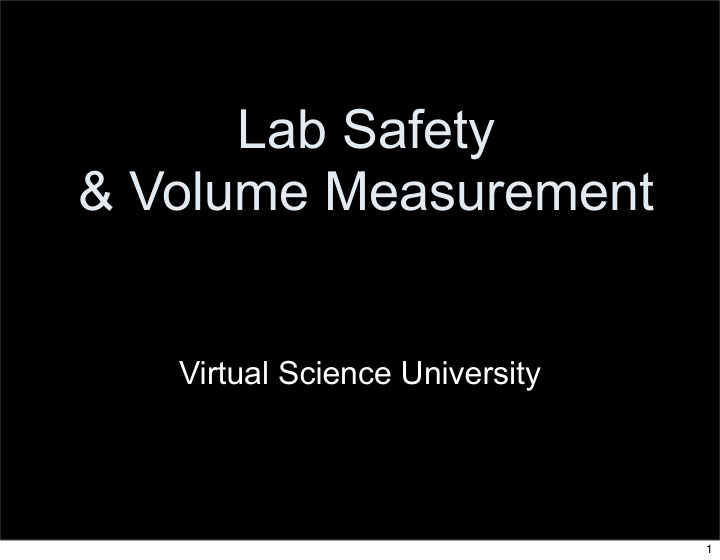



Lab Safety & Volume Measurement Virtual Science University 1
TEK & Objective Lab Safety & Volume Measurement Texas Science TEK B.1(A) Demonstrate safe practices during field and laboratory investigations. 2
Lab Safety Volume Measurement 1. Fire Safety 2. Glassware Safety & Volume Measurement 3. Chemical and Biohazard Safety 4. Sharp Instrument Safety 5. Heat Safety 6. Hand, Eye, & Face Safety 7. Electrical Safety 8. Animal Safety 9. Additional Safety Resources 3
Fire Safety • Know the location of the Fire Extinguisher • Know the location of the Fire Blanket • Know the location of the Emergency Exit • Know the Emergency Evacuation Routes in your school, not just your Science Classroom • Never heat anything, especially chemicals unless instructed by your Science Instructor • Never reach across a flame • Never heat anything in a closed container • Always use tongs, clamps, and heat resistant gloves to handle hot objects or when using a flame • Always keep your work area clean 4
Glassware Safety & Volume Measurement • Never heat glassware that is not completely dry • Always make sure the glassware you pick up, it is never hot • If you do pick up something very hot, make sure you use heat resistant gloves • Always clean glassware thoroughly before putting it up • Always use Fire Safe Glassware, ideally Pyrex Glassware • When working with fluids always use graduated containers either plastic or glass • When measuring fluids always use the SI System of Measurement not the English System. It is good to know the conversions • In the SI System one milliliter of fluid equals one cubic centimeter • Thirty milliliters (ml) or thirty cubic centimeters (cc) equals one liquid ounce 5
Chemical & Biohazards Safety • Never smell any chemical directly from a container • Never mix chemicals unless instructed to do so by your Science Instructor • Never touch or taste any chemical unless instructed to do so by your Science Instructor • When chemical are not in use, keep all lids closed • Dispose all chemicals as instructed by your Science Instructor • Immediately rinse off your skin and clothes with water anytime your skin or clothes come in contact with chemicals. Then, notify your Science Instructor Immediately • Know the location of your Biohazard Containers • Disposal of Biohazards liquids like human blood • Disposal of Sharp Objects in designated Biohazard Containers 6
Sharp Instrument Safety • Always use single edge razors instead of double edge razors • Double edge razors are too dangerous • Handle any sharp instrument with extreme care • Never cut any material towards you, always cut away from you • Notify your Science Instructor immediately if you are cut in the lab 7
Heat Safety You should always wear heat resistant gloves to avoid burning your hands 8
Hand, Eye, & Face Safety • You should always wear Latex Gloves in a Biology Lab Setting • If you have a Latex Allergy, alert your Instructor. • Most schools have Latex Free Gloves for those students with Latex Allergies • You must always wear Safety Goggles to protect your eyes and face • Always point a test tube that is being heated away from you and others • Chemicals can boil or splash out of the heated test tube 9
Electrical Safety • Never use a long extension cord to plug in an electrical device • Do not plug in two many different appliances into one socket otherwise you may overload the socket and cause a fire • Never touch an electrical appliance with wet hands. 10
Animal Safety • Do not cause pain, discomfort, or injury to any animal when working with live animals • Always follow your Science Instructor Directions when handling animals • Always wash your hands thoroughly when working with live animals or their cages 11
Additional Information Relating to Science Lab Safety Any additional information relating to Science Lab Safety can be found at: www.utdanacenter.org/sciencetoolkit/safety 12
Contact Information www.VirtualScienceUniversity.com 1-877-920-5550 13
Recommend
More recommend